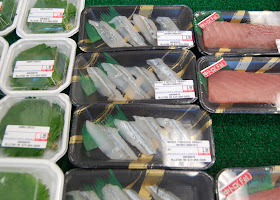As I was battling Boston traffic, I couldn't figure out what I felt more nervous about. Suppose I loved it and wrote favorably about it. Would that upset my standby fishmongers? Suppose I wouldn't like it. Would that upset Sakanaya and its cheerleaders on chowhound? So, before anyone gets upset, let me just say that I am describing an experience of a single person on a single day.
Let me start with the good. Sakanaya has a very friendly staff who knows a lot about fish. One of the questions I ask when I sea fluke, mackerel, or other parasite prone fish sold for raw consumption is "Was it previously frozen?" Freezing will reduce the risk of live parasites to almost zero. But freezing sounds unappetizing to most consumers, so many stores like to dock the question. H-Mart told me that their fish is so fresh it doesn't need freezing. Hmm? Chef's usually joke that if the worms are moving the fish is fresh, so that's not a good answer. Kotobukiya (used to be in Porter Square, but now closed) told me that they freeze all their fish to kill bacteria. Not a good answer either. Freezing temporarily stops bacteria growth, but doesn't kill them. No beating around the bush at Sakanaya. Yoshi, the fishmonger, knew which species are parasite prone and need freezing. He said that everything they carry was flash frozen. They don't have to freeze tuna, he said, because tuna doesn't get the parasites harmful to humans. But the day I came all the tuna they had was previously frozen too.
Indeed, the varieties Sakanaya carries are not easy to find at other stores. Besides salmon, hamachi, branzino, and yellowfin tuna that I can get at other markets, there were needlefish, cobia, sweet shrimp (raw -- not the usual shrimp you get at sushi restaurants), and fatty big-eye tuna.
 |
| Cobia, Sweet Shrimp, Mackerel |
 |
| Shiso leaves, needlefish, fatty tuna |
 |
| Octopus, cooked shrimp, squid |
 |
| Salmon, Tuna |
 |
| Mackerel, branzino, sea urchin |
I tried both nigiri made in store and bought fish to make my own. So, how was it? Unfortunately, it was lackluster. The fish tastes tired. There was none of that glow or juiciness one gets from a perfect piece of fish. Most fish had no flavor (including the fatty-tuna). Eel tasted pasty and dry -- freezer damage? Cobia was exceptionally tough, but not due to mishandling. I've only had Cobia cooked before. It's a very firm fish. I was surprised to see it sold for sushi and wanted to try it. Maybe it's just not my kind of fish.
Of course, it's possible that I caught them on an off day when they don't get new deliveries. But if they are freezing the fish, why should it matter? Besides, New Deal and Marden's get deliveries daily, so there is no bad day to shop. The only thing that might differ day to day is the variety, but the quality is uniformly high.
I find that there is an aura of authenticity around Japanese markets selling fish for sushi. But freshness is not that complicated. If a market moves a lot of fish, the fish is fresher. I don't remember last time I set a foot into my usual fish markets and found myself to be the only customer. Fish is constantly sold and replaced by other fish. At Sakanaya I was the only one during 20-30 minutes I spent there.
If you are not sure of your butchering skills and want slicing to be easy, Sakanaya is worth a shot. But if you want the freshest, tastiest fish in Boston, you should look elsewhere.


I don't care how fresh and wonderful the fish was when it arrived at their place, it's going to suck within hours of it being cut and put in that styro packaging. What a shame.
ReplyDelete